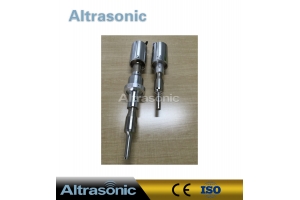Ultrasonic Liquid Processor Laboratory System
Ultrasonic Liquid Processor Laboratory System
Description:
Ultrasound creates acoustic cavitation, which produces violently imploding vacuum bubbles, causing shock waves, microjets and strong shear forces as well as extreme local temperatures (~5,000 K)and pressures (~1,000 atm).
These extreme conditions result in exceptionally efficient mixing, yielding nanoemulsions with very small droplet sizes and enormous contact areas between all components
Specifications:
Model
S20-500
S20-1000
S20-1500
S20-2000
S20-3000
Frequency
20±1 KHz
20±1 KHz
20±1 KHz
20±1 KHz
20±1 KHz
Power
500 W
1000 W
1500 W
2000 W
3000 W
Voltage
220±10% V
220±10% V
220±10% V
220±10% V
220±10% V
Temperature
300 ℃
300 ℃
300 ℃
300 ℃
300 ℃
Pressure
35 MPa
35 MPa
35 MPa
35 MPa
35 MPa
Intensity of sound
>20 W/cm²
>20 W/cm²
>30 W/cm²
>40 W/cm²
>60 W/cm²
Max Capacity
> 3 L/Min
> 10 L/Min
> 15 L/Min
> 20 L/Min
> 30 L/Min
Material Of Tip Head
Titanium Alloy
Titanium Alloy
Titanium Alloy
Titanium Alloy
Titanium Alloy
Ultrasonic Homogenizer Names
Sometimes referred to as, Sonicator, Cell Disruptor, Sonifier, Probe Sonicator, Sonic Dismembrator, and Ultrasonic Liquid Processor.
Applications:
1. Food processing
2. Sonochemistry
Reaction Acceleration – cavitation accelerates chemical and physical reactions.
Fine Particle
Dispersion – e.g. nanoparticle processing
Disruption and Cell Lysing – will break open biological tissues and cells to extract enzymes and DNA, prepare vaccines.
This technology provides a method forultrasonically lysing cells and spores in a liquid flowing continuously or intermittently through a cylindrical reactor.
Homogenization – making uniform mixtures of liquids or liquid suspensions.
Emulsification – processing foods, pharmaceuticals, and cosmetics.
Dissolution – dissolving solids in solvents.
Degassing – removing gases from solutions without heat or vacuum.
3. Inline pipe cleaning, removes scale or build/up without disassembly.
4. Cylindrical 360° internally radiating chamber.
5. Internal or external liquid atomizing or powder making sonotrode.
Ultrasonic working situation Features
Mechanical mixing——Introducing ultrasonic chemical reaction system, the ultrasonic can give substance to be forced to exercise, produce one way energy accelerated the transfer and diffusion of material, can replace mechanical agitation, can make the material from the surface, so that the interface updates.
cavitation effect——Acoustic cavitation is refers to under the effect of sound waves, exists in the tiny air bubbles in the liquid (hole) in a series of dynamic process: oscillation, expand, shrink and collapse. In the event of a cavitation, a great difference to local state of liquid, extreme high temperature and high pressure is produced. As in the general conditions difficult or impossible chemical reaction provides a new very special physical and chemical environment
Catalytic chemical reaction——
① High temperature and high pressure conditions conducive to the reactants cracking into free radicals and bivalent carbon, forming a more lively reaction species;
②Shock waves and micro jet on the solid surface, such as catalyst have desorption and cleaning effect, can remove the surface reaction product or intermediate and catalyst surface passivation layer;
③The shock wave may destroy the structure of reactants;
④Dispersion of reactants;
⑤Ultrasonic cavitation erosion surface, shock waves cause the formation of metal lattice deformation and internal strain area, improve the activity of the chemical reaction of the metal;
⑥Make solvent into the solid interior, produce so-called mixed reaction;



